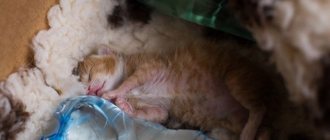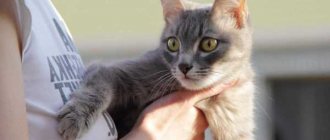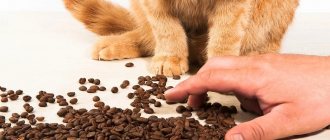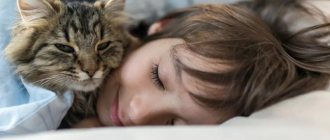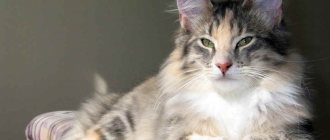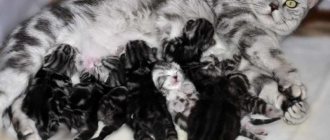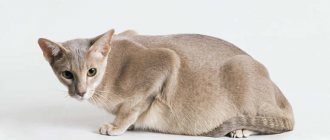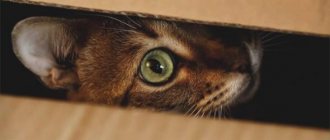Cat food
The cat produces milk immediately after giving birth. This is how nature intended it. Newborn kittens should be fed mother's milk upon birth to get the most out of the antibody-rich colostrum.
In order for milk to appear, you need to feed the nursing mother. Bring some food and water to the animal and place it near her. A cat is unlikely to want to leave her kittens and go far from them to eat. If your cat refuses to eat immediately after giving birth, there is no cause for concern, just offer food a little later.
In order to ensure the health of not only the mother, but also her children, the diet of a nursing cat after birth should be varied and high in calories. Don't limit the serving size. Give as much as he asks. She needs to gain strength.
So, what to feed your cat after giving birth:
- Protein. It is an important building material for any living organism. During the feeding period, part of the supply will be used to produce milk, so you will need to replenish it daily. Give meat, dairy products, fish, eggs.
- Calcium. This element is needed for high-quality milk, as well as to prevent hair loss and tooth decay. Calcium is found in dairy products (milk, kefir, sour cream, cheese).
- Plant products. Oats, lemon balm in milk, cumin, carrots, dandelion - all these plant products will improve lactation.
If a cat refuses to eat after giving birth, then you will need to stimulate her appetite with her favorite food or feed her with a syringe. The animal needs strength and high-quality milk, without which the kittens will simply die.
After childbirth
Complications after giving birth to a cat can occur at any time. These can be problems of any nature. Quite often, a cat does not have milk after giving birth. However, there is no need to worry about the first three days, because colostrum comes first, and it is quite enough to feed newborns. The presence of milk must be stimulated by good nutrition and calmness of the animal itself.
If the kittens still don’t get enough to eat and are constantly screaming, then you will have to supplement them with boiled cow’s or goat’s milk from a pipette
If a cat is restless after giving birth, behaves strangely, and constantly meows, this may mean that something hurts. Mastitis in cats is a common problem. When there is too much milk and babies do not have time to eat it, then it accumulates and turns sour. In this case, the animal will also need your help. Express it a little and carry out the necessary hygiene procedures.
In addition, you may observe diarrhea in your cat after giving birth, however, this is normal. Postpartum diarrhea can be caused by emotional shock after an experience or poor quality feeding.
What to do if maternal instinct is violated?
If the cat was very exhausted from childbirth, or when the last one was frankly difficult and unsuccessful, your pet may simply not have the strength left to care for her offspring. In these cases, the role of “nanny” will have to be taken on by the owner himself.
We have already described above exactly how cats do this in natural conditions. Remember that you need to “imitate” maternal care as carefully as possible, without rushing.
So, the following is required of you:
- Gently remove the remaining membranes, wipe the kitten's nose and open the mouth, then slightly tilt the pet's head down and try to remove all the liquid and mucus from there.
- If the cat has not chewed off the umbilical cord either, measure about two centimeters from the kitten’s navel, tie the umbilical cord with silk thread, and then cut the “lace” (of course, over the knot you tied). The stump must be lubricated with alcohol tincture of iodine. Please note that you cannot simply cut the umbilical cord! We have already written that when a cat bites it, it simultaneously crushes the edges of the organ, thereby preventing the development of bleeding. If you simply cut the umbilical canal, your baby may bleed to death within minutes.
The most difficult thing is when the kitten is not breathing: perhaps he was born tail first and managed to drink in the amniotic fluid. If medical assistance is not provided immediately, the baby may die from suffocation. You can try to remove the liquid using the smallest baby syringe.
Experienced veterinarians advise using a urinary catheter connected to a regular syringe. In addition, you can massage the kitten’s throat, trying to induce a cough (if you’re lucky, the animal itself will spit out all the excess).
Rocking is another simple, but still quite effective method of resuscitation. To do this, place the kitten in your palm with its back facing down and squeeze its head (gently) between your thumb and index finger. After this, it is necessary to rock the baby for about five minutes, and at this time the hand should make movements like a rocking cradle. During motion sickness, fluids entering the respiratory tract will fluctuate and irritate the corresponding receptors. The latter stimulate coughing and, if the kitten is lucky, it will spit out all the excess.
Keep in mind that you shouldn’t pretend to be a centrifuge with your hand: you certainly won’t do anything better for the baby, but it’s quite possible to cause a hemorrhage in the cerebellum.
Normal discharge
After the birth of kittens, the owner must carefully monitor the temperature and discharge of his pet. The birth of kittens ends with discharge. Initially they may be brown or streaked with blood - this is normal.
Postpartum discharge from the loop is an integral part of the body’s recovery. After childbirth, the uterus contracts and expels clear mucus residue. This can last up to three weeks. Veins and a greenish tint in some cases can be considered normal, and in some cases they can be life-threatening. Here you will need the help of a doctor.
Cleanliness of the body and training in neatness
A newborn kitten cannot defecate on its own: its mother helps it by licking its belly and perineum. This is a completely normal natural process that cannot be interfered with. This way the nest is kept clean without human intervention. In the wild, this mechanism serves to protect the den from other predatory animals that may be attracted by the smell of excrement.
If you notice that one of your babies is having trouble urinating or defecating, you can help by gently massaging the perineum with a damp cotton swab, or seek help from your veterinarian.
Attention! Kittens should not be washed until at least the 9th week of life. Discharge from the eyes can be removed with a clean cotton pad moistened with boiled water.
Dangerous discharge from a cat after giving birth
Sometimes it happens that childbirth ends in complications. This occurs due to infection or tissue damage (rupture of tracts). The first sign of dangerous consequences may be a cat’s bloody discharge with an unpleasant odor after giving birth. Bleeding should not last more than 10 minutes. If after this time there is still bloody discharge, then your pet already needs professional help.
Remember, it is difficult to confuse such bleeding with normal discharge. With pathological discharge, the blood is bright scarlet, possibly with the presence of a large number of clots. Normal discharge is brown.
A cat with complications will be constantly in a recumbent state. Don't give her the opportunity to get up. Let him lie there until the doctors arrive. If there is bleeding, the first thing you need to do is take the cat's temperature. If there is no increase in temperature, perhaps the bleeding is due to incomplete disposal of the placenta, a dead fetus (the kitten died in utero) or unsanitary conditions. Scarlet blood with green streaks requires urgent veterinary attention.
Dangerous postpartum hemorrhage
If postpartum bleeding turns yellowish, gray or cloudy green, then this indicates an inflammatory process of the uterus or its walls. Such manifestations can lead to the death of your pet, so you cannot do nothing. If the diagnosis shows that the lesions are serious, then the cat will have the uterus removed.
Symptoms of acute inflammation:
- increased body temperature;
- apathy and lethargy;
- abandonment of offspring;
- complete loss of appetite.
Complications immediately after childbirth can lead to the development of dangerous diseases. This could be pyometra or endometritis. With the latter, the cat screams loudly, arches its back and tries to sit up. In case of illness, kittens are taken from their mother and fed artificially.
You should also not ignore discharge that has a pungent, rotting or sour odor. Call a veterinarian to your home as soon as possible.
Symptoms of eclampsia in cats
Eclampsia is a disease in which a cat experiences a critical decrease in calcium in the blood plasma after giving birth. At increased risk are primiparas, animals with multiple pregnancies and already mature cats. In addition, the disease develops against the background of unbalanced feeding, when the pet’s diet contains few foods containing calcium (dairy products).
Eclampsia in cats after birth has pronounced signs. They are impossible not to notice. The first thing you may notice is the new mother's anxiety. She is trying to hide the kittens; she will constantly drag them somewhere. Or it could be the other way around – complete abandonment of offspring.
Main symptoms:
- apathy;
- pallor of the mucous membranes and conjunctiva;
- rapid breathing;
- increased salivation;
- refusal of any food;
- temperature increase.
All these manifestations will be of an increasing nature. It will be necessary to notice this behavior and condition of the animal in time and consult a doctor.
Endometritis
There are many factors that threaten the life of a giving birth cat. If after giving birth a cat's discharge turns white, you should be wary, because it could be endometritis. Endometritis is a disease characterized by the development of an inflammatory process of the uterine mucosa. This condition is fraught not only with further infertility, but also with the death of the animal.
Symptoms of endometritis:
- thirst or refusal to eat;
- lethargy and apathy;
- body temperature is increased;
- the animal is in search of a cool place;
- the fur under the tail is wet;
- pain in the abdomen due to which the animal screams painfully;
- milk disappears;
- abandonment of kittens (often the cat throws them out of the nest).
White discharge in cats after birth occurs due to infection of the genital organs with fungi, streptococci, and E. coli.
Silence in the house!
A cat's maternal instinct can fail due to human fault. Newborns attract too much attention. Curious children often gather around them, make noise around their beloved pets, fuss, and pick up kittens. Such unnecessary intervention can easily cause a cat’s psycho-emotional disorder and, as a result, its rejection of its offspring.
You should not provoke trouble in the cat family. The best manifestation of care and attention on the part of a person towards pets is to create a favorable environment for them in the house, eliminate stressful situations, protect the nest from external irritants, and darken its location. In such a house the animal will feel calm and safe, and the kids will grow up in normal conditions.
A cat can “cheat” on its offspring not only with a person, but also with other people’s kittens. It happens that an animal begins to care for the children of another cat, and other people’s children are often older than their own.
Pyometra
Postpartum pyometra is a complex pathological disease that cannot be ignored. There is no point in treating the disease; you need to immediately take the cat for surgery. This is the only way you can save your pet’s life.
There are many reasons for the development of the disease. These are mainly birth injuries, a weak immune system, lack of sterility during childbirth and, as a result, infection. Pyometra is accompanied by inflammation and accumulation of pus and mucus in the uterus. The inflammatory process then spreads throughout the reproductive system.
Main symptoms:
- swelling and enlargement of the labia;
- anxiety;
- thirst;
- refusal to eat;
- polyuria;
- rapid breathing;
- temperature;
- trembling in the body.
The disease develops rapidly and it is difficult not to notice its development. The cat breathes frequently and licks its fur to such a state that bald spots appear.
Check weighing
To ensure that kittens are getting enough food and are gaining weight well, you should weigh them daily in the first week of life and at least twice a week for the first month - we recommend keeping a weight gain diary. It is convenient to use electronic kitchen scales for weighing.
The weekly increase should be about 100 grams. By the age of two weeks, healthy kittens should certainly double their original weight. Contact a professional if you suspect your kittens are not gaining weight well. Signs of malnutrition can also include constant squeaking, restlessness, and poor sleep.
Sterilization of a cat after birth
The question of sterilizing cats comes to mind for many owners. Especially if such a need arose immediately after childbirth. Is it possible to sterilize and how long after birth can a cat be sterilized? There is no clear answer. This depends on several factors, the first of which is feeding the kittens. If a pet feeds its offspring, then veterinarians recommend waiting 2-3 months.
Sterilization of cats after birth is not carried out immediately for two reasons:
- If you start the procedure immediately after lambing, the walls of the uterus will lose their elasticity, and this can lead to complications for the health and life of the animal.
- Spaying during postpartum heat is dangerous, as it carries a huge risk of infection.
If two individuals of the opposite sex live in the house, and you want to protect the cat from unwanted pregnancy, then it is worth castrating the male.
Veterinarians advise spaying immediately after the end of postpartum estrus. However, after the operation the pet will need special care. There may be side effects such as indigestion, vomiting, and trembling. To prevent inflammation from occurring, postoperative sutures will need to be treated.
Of course, you can sterilize a cat after giving birth, but these are exceptional cases. The pet must be healthy and have a good appetite. If the doctor does not identify any contraindications, the operation will be performed.
Treatment of a cat after birth
If you are worried about the condition of the new mother and you don’t know if everything is okay, then contact your veterinarian. Today, modern diagnostic methods make it possible to identify any postpartum complications. If necessary, Oxytocin is administered to the cat after birth. The injection helps stimulate lactation, accelerates recovery of the uterus and prevents infections of the reproductive system.
The doctor will prescribe treatment for pathological discharge, taking into account the diagnostic results and the animal’s symptoms. To stop severe bleeding, vasoconstrictor or hemostatic medications will be prescribed. If anti-inflammatory processes have begun in the uterus, then anti-inflammatory or antibacterial agents will be needed.
In order to strengthen the health of a weakened cat, the doctor will recommend a therapeutic diet, vitamins, immunomodulators and mineral complexes. In the most severe cases, surgery is performed. Kittens are separated from their mother and fed artificially.
We're already big
From the age of six months, teenage kittens begin puberty, and within a few months they become adults. Now they are independent and can separate from their mother. The cat treats the remaining individuals in the family differently. She is friendly towards females, but rejects males. This behavior is understandable and logical from the point of view of the laws of nature: “dislike” for a son prevents inbreeding. If the guy has nowhere to go due to, for example, limited space, the cat may change its position over time, which will most likely lead to inbreeding. What the new brood will be like, with or without anomalies, depends on the parents. Note that felinologists often cross close relatives in order to develop a new breed or to consolidate some desired characteristics. However, it is better for the average animal owner to prevent such a phenomenon, since its consequences can be extremely sad: the litter will end up with ugly and sick kittens.
